The Great Wall of China, 1907
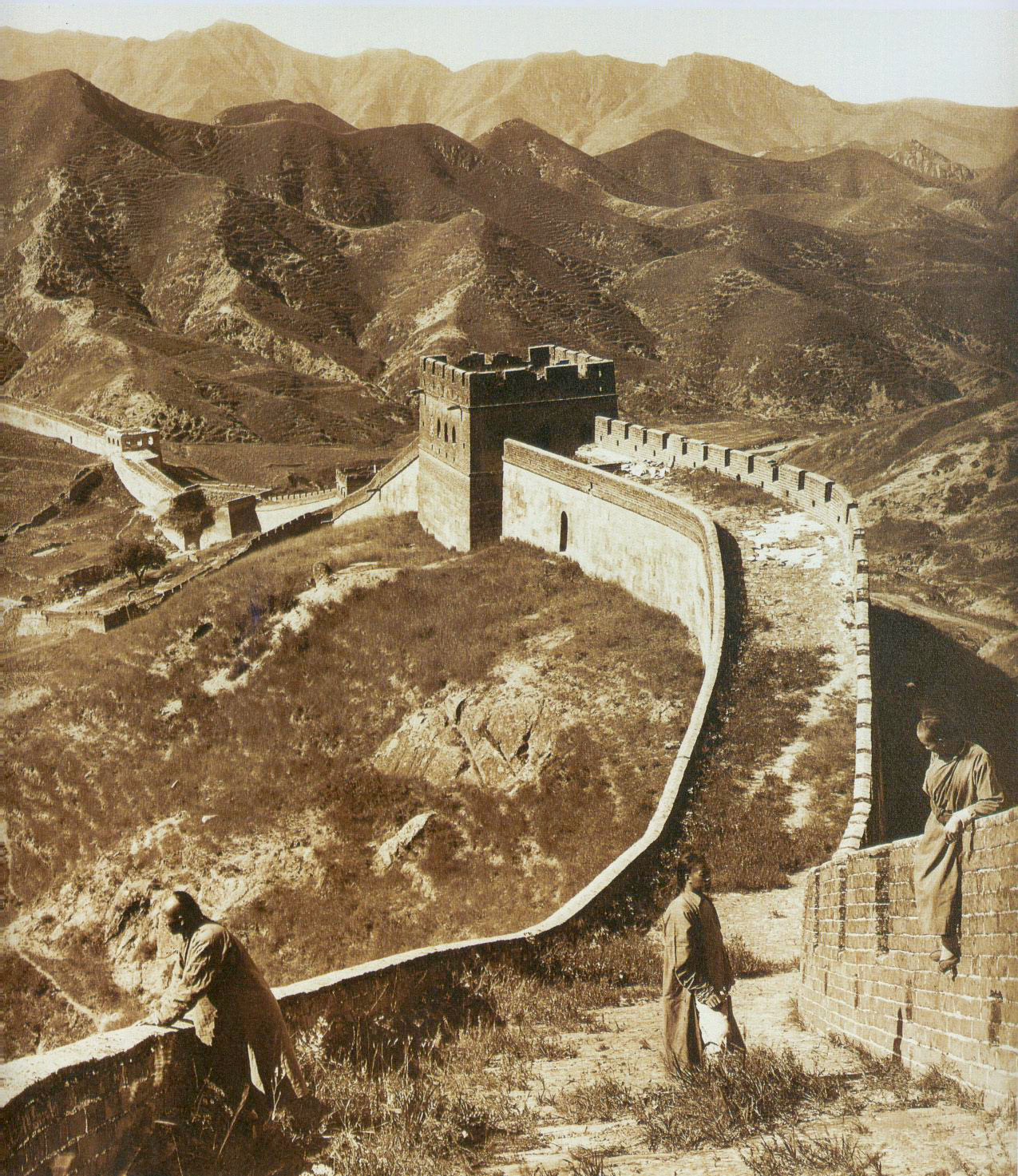
Topics on the Page
China’s explosive population growth between 1750 and 1850.
Decline of the Manchu dynasty beginning in the late 18th century
Growing Western influence
The Opium Wars
The Taiping rebellion from 1850 to 1864
Sino-Korean Relations
Sun Yat-Sen and the 1911 nationalist revolution
- The Three People's Principles and the Future of the Chinese People
- Soong Ching-Ling (Madame Sun Yat-Sen)
Focus Question: What were the major developments in Chinese history in the 19th and 20th centuries?
.png) Here is a video giving an overview about the Asian response to Western Imperialism.
Here is a video giving an overview about the Asian response to Western Imperialism.
1750-1919: An Age of Revolutions. This is an Asia for Educators timeline of China, Japan, Korea, Vietnam and SE Asia, and S. Asia with documents, videos, document based questions and more:
China: 1861 to 1911 offers comprehensive information and teaching materials including power point presentations, videos and primary documents. It is a remarkable resource.
.png) In Pictures:19th century China a collection of Photos taken by a Scottish photographer visiting China in the 19th century.
In Pictures:19th century China a collection of Photos taken by a Scottish photographer visiting China in the 19th century.
Front page, Siku Quanshu, completed 1798

Suku Quanshu, a massive compilation of manuscripts ordered by the Qianlong emperor had 800 million words in 79,000 chapters and 36,000 volumes. The number of words was only surpassed in 2010 when English Wikipedia had over one billion words.
1. Population Growth
- Population surpassed 300 million by 1800, whereas previously it was steadily around 70 to 80 million for more than a few hundred years.
- Due to the huge increase of population with only 10% of land available for agriculture, the Chinese were stretched thin in regards to output of resources.
- There was little land to produce enough wheat and rice to feed its increasing population.
- Natural (drought and famine) and man-made (floods as a result of irrigation systems) catastrophes led to even more problems providing for its people. This was during the Qing Dynasty, also known as, the Manchu Dynasty.
- These factors contributed to the fall of the Manchu Dynasty in that they added increasing pressure on the government to modernize and become more effective administrators, two things Manchu's struggled to do in this time period.
- This huge population also added to China's struggles in the Western powers, the large population made it an easy target to sell opium, which would lead to the Opium Wars.
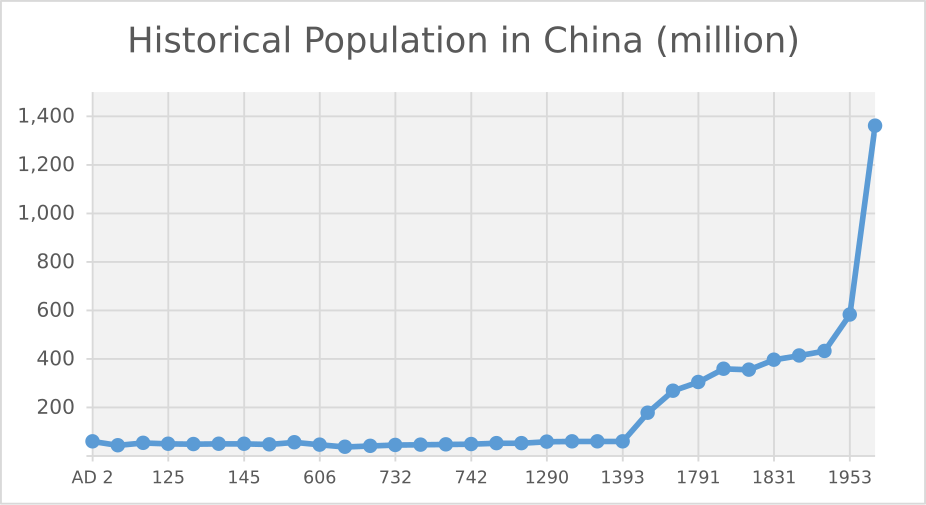
Click here for an interactive map of China and its provinces.
2. Decline in Manchu dynasty

The Manchu dynasty controlled Mongolia, Manchuria, Xinjiang, and Tibet
China had a strong centralized government, yet it had been expanding its empire.
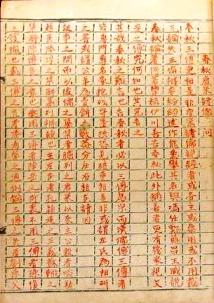
Exam Answers
As the dynasty before them, the Manchus centered their government around the Civil Service Exams. Boys would study the Confucian Classics and test on their knowledge, passing different levels of exams to rise through the ranks of the government.
Peasants became increasingly weak, and the government was continuing to lose money due to the expansion and inability to produce enough resources to compensate with trade.
In combination with the economic difficulty, the internal politics became more and more turbulent. There was also an increase in pressure from internal rebellions.
The Chinese people were unhappy with the lack of democratic reforms added to government which caused major rebellions, such as, the Taiping Rebellion.
The Manchu were also a different ethnicity then the majority of the Chinese people, who identified themselves as Han. In the 17th century, they had invaded from the North. The ethnic tensions between the Manchu and Han were always an issue and in some instances led to violence. The Manchu language is now nearly extinct.
Emperor Kangxi was the second emperor of the Qing Dynasty. He was enthrone at age 7, and ruled for 61 years, making him the longest reigning emperor in China History. He is responsible for the shape of China today. He was part Manchu, and part Mongol. For more information, watch this video on Emperor Kangxi.
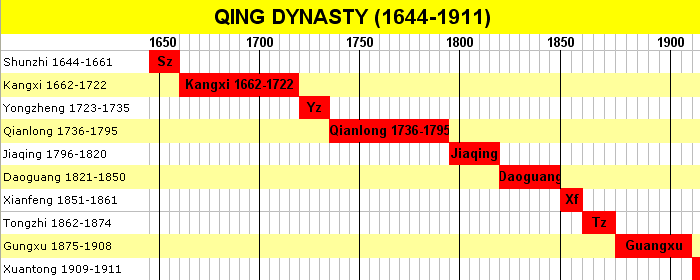 |
| Qing Dynasty Emperors and the years they were in power |
.png) Click here for video: Fall of the Qing Dynasty.
Click here for video: Fall of the Qing Dynasty.
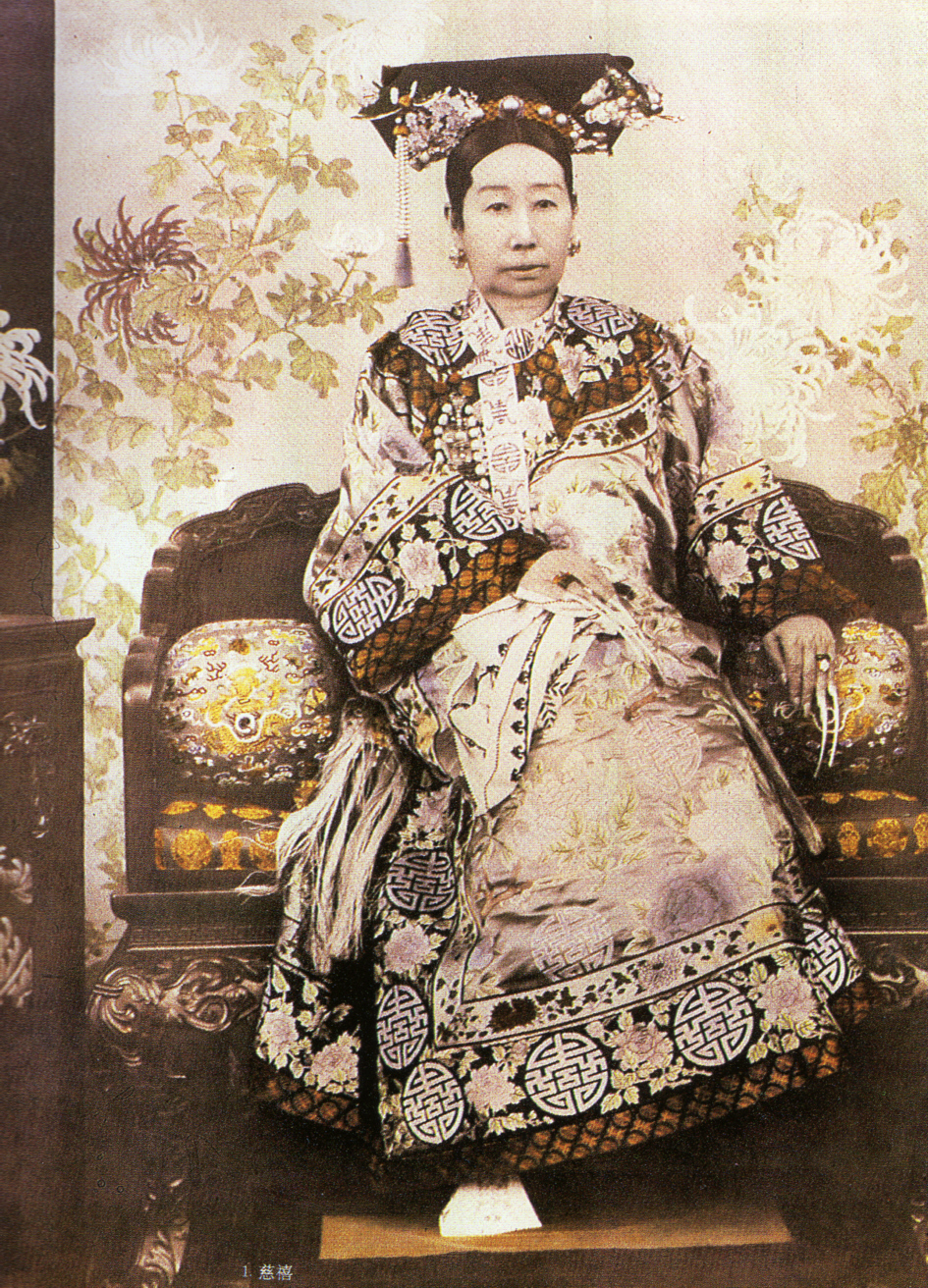
 Empress Cixi
Empress Cixi
Empress Cixi was a contributing factor in the fall of the Qing Dynasty. She opposed changing with the times and disowned her modernist followers.
Like many woman leaders, Cixi does not have a positive representation in history. Click here to read more about her.
3. Growing Western influence
European nations and the United States had been industrializing since the late 18th century, and Great Britain in particular sought to expand its newly found trade mechanisms of cheaper products with faster means of transportation.
- Though China tried largely to keep its large stock piles of precious metals, namely silver, it did trade some with the west. Western powers were colonizing in Asia, but there was still a huge demand for Chinese silk and tea. Great Britain struggled to find any leverage for trade until it began to trade Indian opium to the Chinese.
- At this time, other nations such as Germany and Japan began setting up colonies in China. Setting up the "spheres of influence" in China caused a lot of tension within the country.
The Chinese people did not want foreign influence in their country and had a history of being isolationist. This caused uprisings like the "Boxer Rebellion" which was a movement against colonial powers.
Westerners were kept at a distance from the mainland. While there was a great deal of trade, westerners were not allowed to enter mainland China, nor were they allowed to go to the Forbidden City (Beijing). Instead, they were to stay at Canton, a port in South China. However, some missionaries, like Karl Gutzlaff, snuck into China to spread the word about Christianity.
This primary source reading includes an excerpt from "On the Adoption of Western Learning" by Feng Guifen and questions that go along with the reading.
.png) Click here for lesson plans on Western influence on China
Click here for lesson plans on Western influence on China
4. The Opium Wars
Opium smokers

See also Special Topic Page on the History of Hong Kong
The Opium Wars (1839-1842 and 1856-1860), also known as the Anglo-Chinese Wars, are best conceived as not just wars over opium, as it's name implies, but rather as wars over the foreign trade restrictions imposed by the Chinese government (under the Qing Dynasty) and the problems that the trading of opium from British India posed.
The Chinese enacted strict trade rules on Europeans, notably called the "Canton System" (named after the only place Westerners could trade in china at the time).
- This system left it up to the Chinese customs officials to tax the westerns cargo as they see fit. The westerners thought that this was very unfair. This lead to a lot of smuggling on the part of the westerners.
- It was the act of the East Indian Company (a British-owned trade company) smuggling opium into China and the Chinese government's efforts to enforce its drug laws that sparked the conflict and eventual war.
- For decades, the the Chinese government tried to contain the use of opium, but as addiction grew among the native Chinese, the pervasiveness of opium distribution became menacing and unmanageable.
- Britain defeated the Chinese twice with more advanced technology, thus forcing a number of concessions including trade conditions favorable the British, opening ports to western traders, and handing Hong Kong over to the British.
The Treaty of Nanking ended the first Opium War in 1842, giving the British an indemnity of 21 million pounds, treaty ports, and Hong Kong.
This video is a great 12 minute summary of the Opium wars.
Here is a game about Opium Smuggling.
 Click here and here for lesson plans on the Opium War
Click here and here for lesson plans on the Opium War
Click here to see a military history of how the Europeans were involved in the Opium War.
.png)
Click here for a video (watch up to 3:28) about the Opium Wars and their link to the Taiping Rebellion and how that impacted British trade.
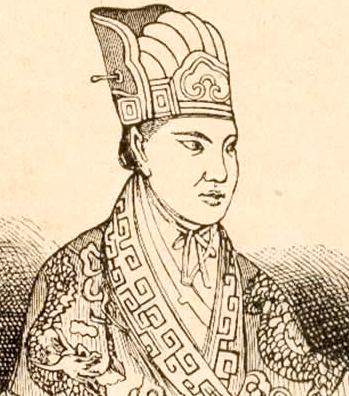 |
| Hong Xiuquan, Leader of the Rebellion |
Led by Hong Xiuquan, a failed Confucian examiner, an army consisting of primarily Protestants revolted against the Qing dynasty controlling significant portions of southern China for nearly twenty years.
The group was both Christian and utopian, instilling social reforms and socialist beliefs on land ownership and calling themselves the Taiping Heavenly Kingdom. The Chinese were eventually able to suppress the rebellion after being supported by the British and French. Estimates of casualties are between 20 and 30 million.
Three important Chinese men who helped to defeat the Taiping were:
Zeng Guofan
Li Hongzhong
Zuo Zongdng.
They raised local armies (known as the Hunan and Anhui Armies) to help defeat the Taiping in Nanking. With the help of the British and French, Hong Xiuquan and his followers were defeated. These three men would be regarded as heroes in China and would hold high job titles.
This rebellion lasted nearly 14 years and showcases the strife felt by the common citizen under the increasingly ineffective Manchu Emperors. China was losing control over its own land bit by bit from 1750 on. Losing it either to westerners who sought more favorable trade agreements (meaning they were highly disadvantageous to the chinese) or they were losing support from their own people as evident by the Taiping Rebellion and the later Boxer Rebellion with all of this culminating to the Chinese Revolution of 1911 which would eventually see the installment of Communism as the ruler of China.
Taiping Rebellion
Click here for a primary source document with questions on the Taiping Movement and it's strengths and weaknesses.
Click here for a lecture by UMass Amherst professor Stephen Platt on the Taiping Rebellion. Platt is discussing his book,
Autumn in the Heavenly Kingdom: China, the West, and the Epic Story of the Taiping Civil War, but he shares fascinating details on the rebellion.
Click here to review a timeline of the events of The Taiping Rebellion.
Sino-Korean Relations in the Late 19th Century (1880s)
China's relationship to Korea had many similar characteristics as European/ Western Imperialism. This occurred during the Qing Dynasty.
The Chinese forced themselves into Korea due to their advances in technology (telegraph, railroad, Maxim gun), a rise in Mercantilism that spread into Korea that attempted to control Korea's trade ports, and their desire to civilize their neighbors (Confucianism).
The difference between Western Imperialism and China's Imperialism was that they did not annex the peninsula. Thus, it was an informal empire.
There was also competition between Japan and native resistance from Koreans.
Here is where I found most of my information, on the same page is a 1.5hr conference from 2008 that discusses it:
https://www.wilsoncenter.org/event/chinese-imperialism-the-korean-peninsula-historical-window-sovereignty-and-power-relationships
Here is a primary document that discusses trade relations from 1882-3: (it is just a preview, but the message comes across)
https://www.tandfonline.com/doi/abs/10.1080/12265087609431847?journalCode=rger19
It is important to note that American imperialism affected China. Limits on Immigration, constriction of trade, and Britain's control were used as models.
Here is a resource that discusses the complicated history of America and China:
https://www.heritage.org/asia/report/the-complicated-history-us-relations-china
- this can help create a clearer picture of what caused China to act this way.
Sun Yat-Sen and the 1911 revolution
Sun Yat Sen, 1908

Click here to watch a video explaining the rise of nationalism and communism in China.
Discontent and political instability eventually led to the 1911 revolution, also known as the Xinhai Revolution, in which a republic was implemented. The Qing dynasty had incredible difficulty dealing with western imperial nations and struggled with its own government corruption and ethnic conflict. The 1911 revolution effectively ended over two millennia of dynastic rule in China.
 Sun Yat-sen was one of the main leaders of the revolution who hoped to instill a Han majority, strong nationalism, and more democratic and socialist reform. A weak and fragmented government was initially formed, followed by a monarchy and military rule. This period of instability lasted until the People's Republic of China was officially established in 1949.
Sun Yat-sen was one of the main leaders of the revolution who hoped to instill a Han majority, strong nationalism, and more democratic and socialist reform. A weak and fragmented government was initially formed, followed by a monarchy and military rule. This period of instability lasted until the People's Republic of China was officially established in 1949.
Sun Yat-sen "The Three People's Principles and the Future of the Chinese People"
Nationalism. Finding evidence of proto-nationalism throughout Chinese history, Sun believed that he had enlarged and modernized the principle to include opposition to foreign imperialism and a firm sense of China as an equal among the nations of the world. He also addressed the need for self-determination for China's minorities.
Democracy. Finding important Chinese precedents for the notion of the voice of the people, Sun introduced the new notions of a republican government and a constitution as the best way to articulate and protect people's rights. Sun advocated popular elections, initiative, recall and referendum, but he felt that China was not yet ready for full democracy, requiring instead a preparatory period of political tutelage.
Livelihood. Sun believed in both economic egalitarianism and economic development. He sketched out a complicated plan to equalize land holdings and ensure that taxation was both widely and fairly implemented. Dedicated to industrialization but concerned about China's difficulty in securing investment capital and also about social unrest, Sun advocated nationalization of key industries as the best way to ensure both economic development and political stability. Read more here.
Kang Youwei was a born in 1859 to a scholarly family. While studying for the Civil Service Exams, he created his own philosophy and was heavily influenced by the British population in Shanghai. In 1883 he made plans to abandon the civil service exams, and devoted his life to western views, education, society, and government. Kang Youwei developed the teaching on the New Text, as he believed the New Text were the actual works on Confucius, which went against the common understanding in China at the time.
- Kang Youwei also got the attention of Emperor Guangxu which sparked the 100 Day Reform
- Click here for even more information on the 100 Day Reform.
Qiu Jin: A Heroine in China's Anti-Feudalist Cause
Women in World History: Western Views of Chinese Women
- The role of women in 19th Century China is displayed simply in the presentation found here.
Half length portrait of Soong Ching-Ling (Madame Sun Yat-Sen) between 1939 and 1945
.png) Soong Ching-Ling
Soong Ching-Ling

Madame Sun Yat-Sen: wife of Sun Yat-Sen the leader of the 1911 Nationalist Revolution.
She was an advocate for women's rights in China.
Timeline of Her Life
Soong Qingling: The Mother of Modern China
The Soong Sisters: The Forgotten Women Who Shaped China in the 20th Century
Sources
Columbia University, (2006). Asia for Educators. Retrieved February 26, 2007, from Sun Yatsen's "Three People's Principles." Web site: http://afe.easia.columbia.edu/china/modern/rd_bck.htm
Columbia University, (2006). Asia for Educators. Retrieved February 26, 2007, from “Reform to Revolution." Web site: http://afe.easia.columbia.edu/china/modern/rd_bck.htm.
Duiker & Spielvogel, William J. (2005). The Essential World History. Belmont, CA: Wadsworth Group/Thomson Learning.
Columbia University, (2006) Asia for Edcucators. Retrieved February 27, 2007, Web site: http://afe.easia.columbia.edu/china/modern/back.htm.
Columbia University, (2006), Asia for Educators. Retrieved February 27, 2007, “The Opium War and Foreign Encroachment,” from http://afe.easia.columbia.edu/china/modern/opium.htm.
Columbia University, (2006), Asia for Educators. Retrieved February 27, 2007, “Introduction to China’s Modern History.” Web site: http://afe.easia.columbia.edu/china/modern/back.htm.
Columbia University, (2006), Asia for Educators. Retrieved February 27, 2007, “Introduction: Rebellions and Revolts,” Web site: http://afe.easia.columbia.edu/china/modern/rbl tch.htm
Duiker & Spielvogel, William J. (2005). The Essential World History. Belmont, CA: Wadsworth Group/Thomson Learning.
Preston, Diana (2000).The Boxer Rising. Asian Affairs. 31, 26-36.
http://www.youtube.com/watch?v=nfIFU9AMukM
http://acc6.its.brooklyn.cuny.edu/~phalsall/texts/taiping.html
<< First < Previous Next > Last >> Help · About · Blog · Terms · Privacy · **Support** · **Upgrade**Contributions to http://resourcesforhistoryteachers.wikispaces.com are licensed under a Creative Commons Attribution Share-Alike 2.5 License.
Portions not contributed by visitors are Copyright 2008 Tangient LLC.
http://www.ducksters.com/history/china/civil_service_government.php
Comments (0)
You don't have permission to comment on this page.